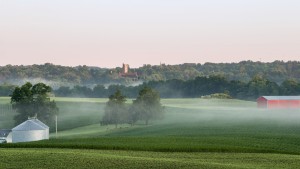“Look at the map again. It should be somewhere around here.”
The summer before my senior year of high school, my mom and I took a Midwest road trip to visit colleges. Though I’d seen schools I liked, I hadn’t seen a school I loved, and I began to worry the picture-perfect college that had sent me postcards featuring owls over Old Kenyon and idyllic images of Middle Path might not really exist.
It would make sense if we couldn’t find it. It had to be an illusion.
“There’s the sign!”
Ok, never mind, it’s real.
Rolling through the cornfields and up the Hill on my first visit to Kenyon, I wasn’t sure what I would find.
At the top of the steep slope, the first thing I spotted was Finn House, with its lacy edges and ideal perch on the cusp of the Hill. It took me a few seconds to notice the sign and realize it was actually a part of the College. As we continued to Wiggin Street, students with backpacks strolled across the crosswalk; suddenly pedestrians seemed to own the road.
The campus blossomed into view through the open car windows, revealing two weathered stone pillars, beyond which an expanse of green was traversed by a single gravel path. Though I knew this to be Middle Path from the postcards I had received, it seemed even more alluring in person, rolling out toward Old Kenyon through a tunnel of elegantly towering trees.
Like all high school students on college visits, I wasn’t able to fully retain the names and functions of every building I walked past on my tour. My dominant impression of Kenyon was not a list of details and departments, but a feeling. Walking down Middle Path I totally tuned out the poor tour guide. I looked over at my mom and smiled, trying not to beam like a little kid. Eager to seem mature and cool and fit in with the college students strolling past me, I nodded at the tour guide and looked around casually, glancing up at the trees every time I caught myself smiling too enthusiastically.
Though a big thunderstorm was looming and we had a long drive back to Philadelphia ahead of us, I begged my mom to stay for the info session, arguably the most boring part of every college visit. I didn’t really need more info on student organizations, class sizes and structures, or housing options, but I just wasn’t ready to leave Kenyon. I spent the long ride home and the next couple of weeks flipping through all the materials I’d picked up from the admissions office, pestering my parents and 12-year-old brother with so many Kenyon facts and pictures they could have applied to be tour guides themselves. I propped up my new Kenyon materials in my room and powered through long nights editing and rewriting my Common App essay, imagining the admissions officers I had just met pouring over thousands of applications in Ransom Hall, hoping mine would get noticed.
As I write this blog, I’m sitting in the third-floor room of my NCA, having just arrived on campus after driving back from my last spring break. The final hour-and-a-half of back roads through expansive farmland no longer concerns me, but comforts me. The sprawling fields and open blue sky are the “almost there” of the drive to Kenyon, the final bit of separation from the packed and hurried highways that keep this hill so magically concealed. Climbing the Hill onto Wiggin Street, I felt the same excitement I had on my first visit, looking around as if everything were new while also scanning the sidewalks, wondering whose will be the first familiar face I see.
While I idealized the seemingly unreal Kenyon before I became a student here, I have now lived almost four full years at the real Kenyon. I have trudged to 8 a.m. classes in zero degree weather, seen the demolition of the old bookstore and the ribbon cutting of the new, caught the Kenyon Krud at the worst possible times, and spent an entire day in Peirce Pub writing comps on one hour of sleep. I have savored 28-mile bike rides on the Gap Trail, chased friends with snowballs on the freshman quad, spun multiple turns on the dance concert stage, and smiled until my cheeks were sore watching friends’ a cappella concerts. I have taught five classes of students how to conjugate the French subjunctive, made a mini interferometer on a lab table and graphed hypothetical gravitational waves, debated the effectiveness of international intervention in civil wars, and discussed the challenges and possibilities of translating poetry.
I no longer idealize Kenyon as the hidden and magical new world I first saw four years ago; the collegiate gothic Ascension Hall and rolling lawns and New Side sunrises are now colored by my own experiences. The last view I will have of Kenyon this year will be going down the Hill. As magically as it seemed to appear when we drove up the Hill on my first visit to Kenyon, this time it will be receding behind me. Chances are, as the years go by, I will idealize Kenyon again. But this time, a lived experience, memories and photo albums filled with my own images and stories from the Hill, will serve as proof that it wasn’t all just an enchanting mirage.
In my Common App essay I wrote about being perfectly content when I was fully absorbed in an experience — even though I knew that the contentment was necessarily limited by and defined by time. My time at Kenyon is ending. I have a sense that what was imperfect, what couldn’t live up to my expectations, will fade in comparison — the Kenyon of my imagination and the Kenyon of my memories will be more closely aligned, and I’m okay with that.

